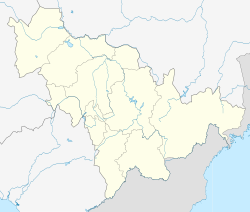Hwando
| UNESCO World Heritage Site | |||||||||
|---|---|---|---|---|---|---|---|---|---|
 | |||||||||
| Location | Jilin, China | ||||||||
| Part of | Capital Cities and Tombs of the Ancient Koguryo Kingdom | ||||||||
| Criteria | Cultural: (i)(ii)(iii)(iv)(v) | ||||||||
| Reference | 1135-003 | ||||||||
| Inscription | 2004 (28th Session) | ||||||||
| Area | 3,219.21 ha (7,954.8 acres) | ||||||||
| Coordinates | 41°9′51.2″N 126°6′55.9″E / 41.164222°N 126.115528°E | ||||||||
| Chinese name | |||||||||
| Chinese | 丸都山城 | ||||||||
| |||||||||
| Korean name | |||||||||
| Hangul | 환도산성 | ||||||||
| Hanja | 丸都山城 | ||||||||
| |||||||||
Hwando (Korean) or Wandu (Chinese), was a mountain fortress of the ancient Korean[1] kingdom of Goguryeo, built to protect Goguryeo's second capital, Gungnae, in Manchuria.
History
In 3 AD, King Yuri of Goguryeo moved the capital to Gungnae Fortress, and built the Wina Rock fortress.[2] Gungnae Fortress, the capital, was a fortress on Yalu River's plain, while "Wina Rocks fortress" (Hangul: 위나암성, Hanja: 尉那巖城) was a fortified city in the mountain which was later renamed to Hwando by King Sansang of Goguryeo.
Goguryeo consolidated its power and began to threaten the Chinese commanderies, under the nominal control of Wei. In 242, Dongcheon attacked a Chinese fortress near the mouth of the Yalu River leading to the Goguryeo–Wei War; in 244, Wei invaded Goguryeo and sacked Hwando.[3]
Goguryeo ended China's presence on the Korean peninsula by conquering the Lelang commandery in 313. However, Goguryeo faced opposition by the proto-Mongol Xianbei who had conquered northern China; the Murong clan of the Xianbei attacked Goguryeo and sacked Hwando in 341, capturing thousands of prisoners to provide cheap labor. The Xianbei also devastated Buyeo in 346, accelerating Buyeo migration to the Korean peninsula. Goguryeo, though temporarily weakened, would soon recoup and continue its expansion.[3]
UNESCO World Heritage Site
The remains of the mountain fortress are part of the UNESCO World Heritage Site Capital Cities and Tombs of the Ancient Koguryo Kingdom. It is located 2.5 kilometers west of Ji'an, Jilin province in Northeast China, near the North Korean border. It is part of the UNESCO World Heritage Site Capital Cities and Tombs of the Ancient Koguryo Kingdom, together with nearby Guonei City and the Wunü Mountain City.
Gallery
-
Entrance plaque
-
Detail of a wall
-
Remains of a guard tower
-
Goguryeo tombs near Hwando
References
- ^ Complex of Koguryo Tombs (UNESCO/NHK) (Youtube). UNESCO. 2010.
- ^ Volume 13(page 18) of Samguk Sagi
- ^ a b Tennant, Roger (2012). History Of Korea. Routledge. p. 22. ISBN 9781136167058. Retrieved 29 October 2017.






